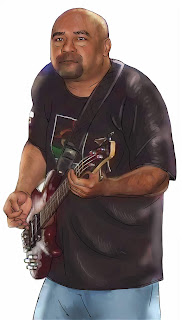Monday, 31 December 2012
Thursday, 27 December 2012
Caricatures for the Band...
This was a cool project. Mike's in a band and wanted caricatures of all the band for marketing. His first run at it he got everyone, then he came back. One of the band members left. Unfortunately the artist that did his original caricatures was not available. Not to despair, our artist Jay made it to the rescue. He was able to duplicate the look and feel and Mike was really happy with his caricature.
Can you tell the one Jay did? Answer below
The compliment he gave us was:
Hello,
Yesterday I gave feedback on Ray and accidentally selected "dislike".
That is certainly not the case. His work was stellar and his turnaround time was fantastic.
Please do what you can to remedy my error as he is a great asset to your site.
I WILL be back again.
thanks again
Mike E.
The caricature Jay did to match the others was the LAST at the bottom.
Tuesday, 25 December 2012
Saturday, 22 December 2012
Thursday, 20 December 2012
Awesome Video of TV Caricatures....
Here's a great video of TV caricatures. They might be caricatures but I'm sure you'll agree these are more than that, they are world class works of art, not just caricatures. Maybe you want one for yourself, a family member or friend, we have over 30 different artists to chose from. Everyone loves a caricature.
Tuesday, 18 December 2012
What is a caricature - Some History....
What is Caricature?
Caricature is a distorted picture of a person, intended to be humorous, satirical, or insulting. The caricaturist usually exaggerates an easily recognized feature of the subject's appearance or habits, such as a large nose, bushy eyebrows, an unfriendly expression or a distinctive way of dressing.
Until recently, affectionate caricature was less common, which emphasizes some admired or warmly regarded trait. The subject of a caricature may be either a particular person or an easily recognizable type. Usually the caricature can be appreciated only if its subject is well known.
A political cartoon, for example, may caricature a public figure by endowing him with animal characteristics. Political leaders are constantly caricatured in cartoons that appear in newspapers and magazines. These caricatures are intended as comments on political events, and they may show politicians as praiseworthy, ridiculous or even evil.
Literary forms of caricature include satire, parody, and burlesque, all of which ridicule subjects through comic exaggeration. The term "caricature", however, generally refers to pictorial representations.
Caricature in the modern sense, the distortion of a real person or type, was first practiced by such Renaissance artists as Leonardo da Vinci and Albrecht Diirer. Extreme exaggeration characterizes the 16th-century grotesque art of Hieronymus Bosch and Pieter Brueghel. At the same time, caricature became an independent art in the satirical portraits of Annibale Carracci.
The term caricatura was first used by Annibale Carracci, the classical painter, to signify drawings pregnant with wit (caricare, to load).
Caricature is a distorted picture of a person, intended to be humorous, satirical, or insulting. The caricaturist usually exaggerates an easily recognized feature of the subject's appearance or habits, such as a large nose, bushy eyebrows, an unfriendly expression or a distinctive way of dressing.
Until recently, affectionate caricature was less common, which emphasizes some admired or warmly regarded trait. The subject of a caricature may be either a particular person or an easily recognizable type. Usually the caricature can be appreciated only if its subject is well known.
A political cartoon, for example, may caricature a public figure by endowing him with animal characteristics. Political leaders are constantly caricatured in cartoons that appear in newspapers and magazines. These caricatures are intended as comments on political events, and they may show politicians as praiseworthy, ridiculous or even evil.
Literary forms of caricature include satire, parody, and burlesque, all of which ridicule subjects through comic exaggeration. The term "caricature", however, generally refers to pictorial representations.
Caricature in the modern sense, the distortion of a real person or type, was first practiced by such Renaissance artists as Leonardo da Vinci and Albrecht Diirer. Extreme exaggeration characterizes the 16th-century grotesque art of Hieronymus Bosch and Pieter Brueghel. At the same time, caricature became an independent art in the satirical portraits of Annibale Carracci.
The term caricatura was first used by Annibale Carracci, the classical painter, to signify drawings pregnant with wit (caricare, to load).
Saturday, 15 December 2012
Subscribe to:
Posts (Atom)















